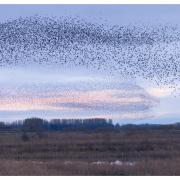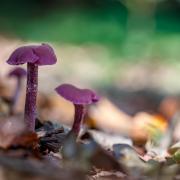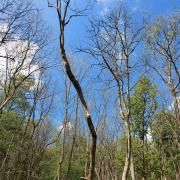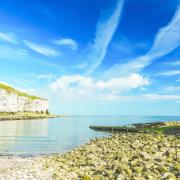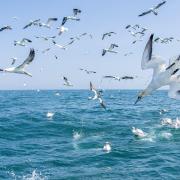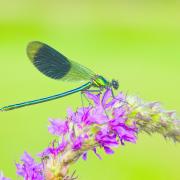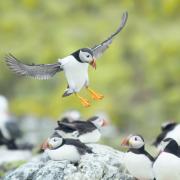On the turn of every tide, a world of marine life in miniature becomes apparent on the shoreline of Flamborough – if you know where to look. Yorkshire Wildlife Trust’s Jess Charlton leaves no stone unturned to discover what lies beneath.

Flamborough is a place like no other. Located on the county’s Heritage Coast north of Bridlington, this chalk headland juts out into the North Sea; one of only a handful of Yorkshire coastal promontories, along with Spurn Point further south, and Filey Brigg.
This whole headland is unique in northern England, as everything is white: the cliffs, the boulders – even the pebbles. Among these dazzling locations sits South Landing.
While the British weather always keeps us guessing, the most dependable of nature’s timelines is the tide. Twice every 24 hours, the waters sweep in to the shore and then back out, exposing boulders, reefs and rockpools. Exploring these underwater microcosms is a wonderful experience at any time, but it is best at a spring tide, which usually happens two days after the date of a new and a full moon when the moon comes directly between the sun and the earth. The effect of this phenomenon is to pull the seawater further from the shore, exposing a zone that can only be reached at spring tide.
While time and tide famously wait for no one, exploring the shoreline in late summer is perhaps most enjoyable, with the sun on your back and the family in tow during the school holidays.

When a snorkel and mask would be required at any other time, it’s these very special tides that bring the most astonishing wildlife tantalisingly close.
Although the relative calm and serenity of the summer seems the best time to explore the coast, it is the winter storms we have to thank for maintaining and creating rockpools. Large boulders crash into the coastal reef forming craters that over time are made deeper and wider as smaller boulders and pebbles are rolled in by the waves to scour the inside. You may think this would put an end to many of the creatures you’re searching for, but they are well adapted. Some will take refuge within the deeper cracks and crevices, others will protect themselves with armour and many have absolutely no protection at all, but squishy creatures cope surprisingly well in turbulent waters.
Top of the list of impressive squishy creatures has to be the beadlet anemone. They are unassuming, pulling in their tentacles with a blob of seawater to keep them hydrated when the tide is out. And while they appear firmly attached to the rock, they can in fact move around, either by releasing themselves and floating to a new spot, or by slowly sliding.
Some sea anemones, like the beadlet, have an impressive lifespan. The true magic of their longevity is in their methods of reproduction: the beadlet anemone can reproduce through internal fertilisation, giving birth to fully formed sea anemones that come out of their mouth; or they can also duplicate through a process called budding, where a small part breaks off and forms a little clone; or they can split themselves in two, through a process called fission, producing a full-sized clone of themselves. With such an impressive life cycle they seem almost immortal, and like the best survivors their secret weapon is well hidden – in the shape of a small set of stinging ‘beads’ below the tentacles, put to use in fights over territory or when provoked.

Searching through the seaweed at South Landing you may see many marine snails such as periwinkles. Edible periwinkles tend to prefer feeding on serrated wrack and flat periwinkles eat bladder wrack, the seaweed that resembles bubble wrap. The air-filled chambers help to float this seaweed upright once the tide returns. Flat periwinkles are often hard to spot as they resemble the green poppers of bladder wrack.
As you uncover the rock and pools below you may spot other types of seaweeds such as the bright, green sea lettuce and the pink, chalky coral weed. Tilting a rock or a pebble on its side can reveal all sorts of wonderful marine creatures underneath, but do not try to move anything too large. If it is bigger than your head, it’s usually best to leave it where it is.
The rocky shore is also a nursery for crabs. Some, like the broad-clawed porcelain crab, are so well camouflaged they can be completely invisible until they move. This can be a handy string to your bow when at low tide the beach becomes a fly-through restaurant for hungry gulls. Along with creative camouflage, crabs will wiggle into cracks and crevices, or partially bury themselves in sand and gravel. Hermit crabs are a particular favourite, but are tricky to find as they use shells belonging to marine snails such as topshell and whelk. Shy and elusive characters, a little patience can be required for them to – quite literally – come out of their shells.
Fish also have to keep out of the way of gulls and other seabirds feeding on the shore at low tide. Some fish living along the rocky shore will bury themselves underneath boulders and pebbles, excavating whatever is in their way, thus protecting them not only from being eaten but also from the strong light and heat of the sun. Indeed, as mid-summer rock pools heat up in the sunshine, most creatures are thankful of the refreshing turn of the tide.

The fish you are able to see within South Landing rockpools are diverse: shanny, goby, butterfish, flatfish and rockling to name but a few. Each has distinctive markings and colours. But fish are fragile; catching them while rockpooling is really best done with a camera rather than a net. A great tip is to use a polarising filter to prevent reflection.
Moving down the shore you will start to notice seaweed dangling in front of rock overhangs, which provide shelter for sponges and sea squirts. Breadcrumb sponge is easy to find at South Landing as its yellow, ochre colour makes it stand out. Sandy, gravelly pools are a good spot to find the sand mason worm which make a protective cast out of tiny fragments of sand and gravel. Look out for the dahlia anemone, which also uses fragments of sand and gravel to disguise itself.
When the tide reaches its furthest limit, particularly on a spring tide, the edges of the kelp forest are exposed. Many creatures use kelp forests for food and shelter and sometimes become caught in rockpools. Lumpsuckers are another fabulous fish that have been spotted at South Landing. These fish have specialised fins on their belly that work a little like suction cups, perfect for hanging around a swaying forest of kelp. You may be lucky enough to spot a starfish or shore urchin, two related marine creatures that often camouflage themselves with gravel and empty shells. And if you inspect kelp fronds you may be treated to a blue-rayed limpet, when you can use a magnifying glass to highlight their wonderful blue stripes, a great finale to your summer visit.

National Marine Week 2017
Actually taking place over a fortnight during late July and early August, there’s a host of events up and down the Yorkshire coast. To kick start your seashore exploration at Flamborough, visit the Yorkshire Wildlife Trust’s Living Seas Centre at South Landing, for hints, tips and advice on rockpooling along with regular Seashore Safaris where you can join in the action. ywt.org.uk/living-seas-centre.












